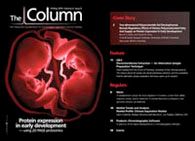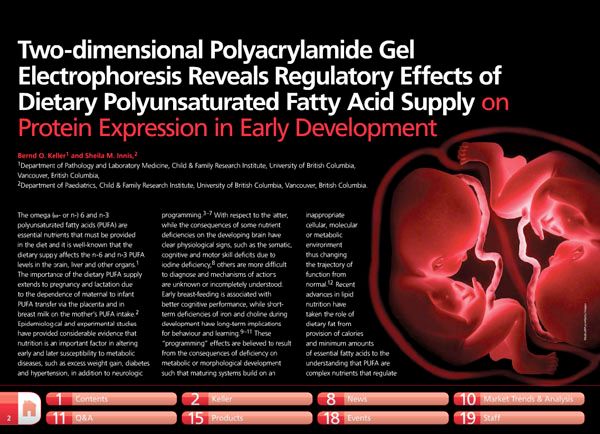Two-dimensional Polyacrylamide Gel Electrophoresis Reveals Regulatory Effects of Dietary Polyunsaturated Fatty Acid Supply on Protein Expression in Early Development
Two-dimensional polyacrylamide gel electrophoresis reveals regulatory effects of dietary polyunsaturated fatty acid supply on protein expression in early development.
The omega (ω- or n-) 6 and n-3 polyunsaturated fatty acids (PUFA) are essential nutrients that must be provided in the diet and it is well-known that the dietary supply affects the n-6 and n-3 PUFA levels in the brain, liver and other organs. The importance of the dietary PUFA supply extends to pregnancy and lactation due to the dependence of maternal to infant PUFA transfer via the placenta and in breast milk on the mother’s PUFA intake. Epidemiological and experimental studies have provided considerable evidence that nutrition is an important factor in altering early and later susceptibility to metabolic diseases, such as excess weight gain, diabetes and hypertension, in addition to neurologic programming. With respect to the latter, while the consequences of some nutrient deficiencies on the developing brain have clear physiological signs, such as the somatic, cognitive and motor skill deficits due to iodine deficiency, others are more difficult to diagnose and mechanisms of actions are unknown or incompletely understood. Early breast-feeding is associated with better cognitive performance, while short-term deficiencies of iron and choline during development have long-term implications for behaviour and learning. These “programming” effects are believed to result from the consequences of deficiency on metabolic or morphological development such that maturing systems build on an inappropriate cellular, molecular or metabolic environment thus changing the trajectory of function from normal. Recent advances in lipid nutrition have taken the role of dietary fat from provision of calories and minimum amounts of essential fatty acids to the understanding that PUFA are complex nutrients that regulate gene expression and protein function to coordinate energy substrate utilization, cellular communication and the response to immune and inflammatory challenges, including oxidative stress. Elucidation of the importance of PUFA in development, however, is complicated by the shifts in expression and repression of genes during prenatal development and during adaptation to the extra-uterine environment. Nutritional proteomics, with a combination of two-dimensional polyacrylamide gel electrophoresis (2D-PAGE), in-gel digestion and mass spectrometric identification of differentially expressed proteins, offers the opportunity for discovery of proteins regulated by specific nutrients, such as PUFA, across different life stages and in different organs and cells.

Analytical Challenges in Measuring Migration from Food Contact Materials
November 2nd 2015Food contact materials contain low molecular weight additives and processing aids which can migrate into foods leading to trace levels of contamination. Food safety is ensured through regulations, comprising compositional controls and migration limits, which present a significant analytical challenge to the food industry to ensure compliance and demonstrate due diligence. Of the various analytical approaches, LC-MS/MS has proved to be an essential tool in monitoring migration of target compounds into foods, and more sophisticated approaches such as LC-high resolution MS (Orbitrap) are being increasingly used for untargeted analysis to monitor non-intentionally added substances. This podcast will provide an overview to this area, illustrated with various applications showing current approaches being employed.
New Method Explored for the Detection of CECs in Crops Irrigated with Contaminated Water
April 30th 2025This new study presents a validated QuEChERS–LC-MS/MS method for detecting eight persistent, mobile, and toxic substances in escarole, tomatoes, and tomato leaves irrigated with contaminated water.

.png&w=3840&q=75)

.png&w=3840&q=75)



.png&w=3840&q=75)



.png&w=3840&q=75)












